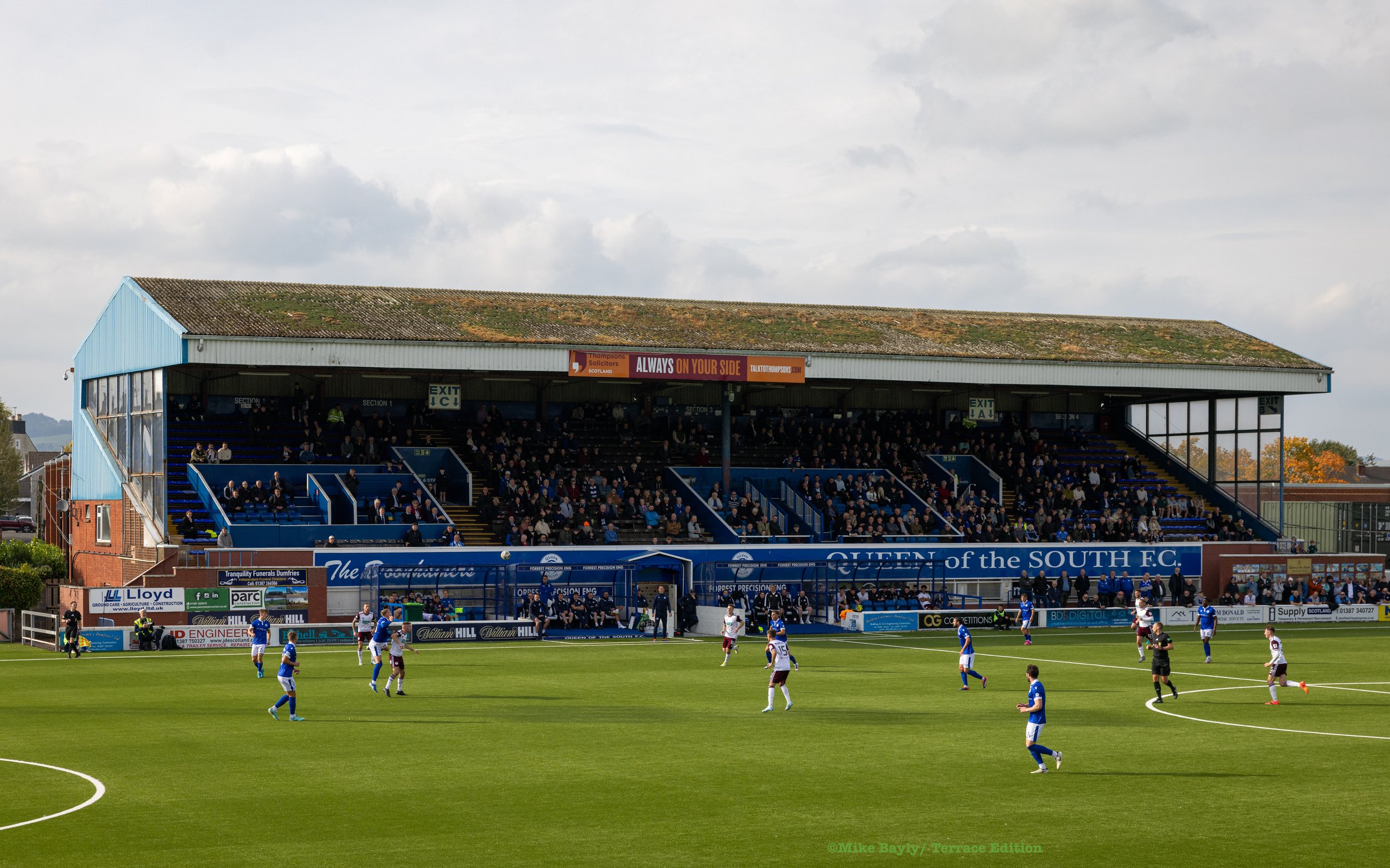The Beautiful South

Words: Mike Bayly
Images: Mike Bayly
It’s written in the stars, it’s just a matter of time…
The train stopped at Preston. A points failure near Carnforth had suspended all services. As a seasoned public transport user, I’m accustomed to delays. I often contemplate how many hours I’ve lost to queuing, waiting or procrastinating.
It must amount to months. Maybe years. A profligate waste of that most valuable commodity: time. Gazing out of the window of a stuffy carriage as wasted minutes ticked by, I pondered the line “time is the fire in which we burn”.
Poetry scholars will recognise if from Calmly We Walk through This April’s Day. I first heard it in Star Trek.
My journey would end, two hours late, in Dumfries. Barely twenty-five miles from the Anglo- Scottish border, natives of the town are nicknamed ’Doonhamers’, a portmanteau of Scottish dialect ‘Doon hame’ (down home) used by locals returning from the north to Dumfries’ South of Scotland location.
Football, inevitably, had taken me here.
The Scottish game offers an abundance of delights to the itinerant watcher, not least its club names, drenched in cultural romanticism: Forres Mechanics, Inverurie Loco Works, Bonnyrigg Rose, Kirkintilloch Rob Roy and, my destination today, League One leaders Queen of the South, for their fixture against Kelty Hearts.
©Mike Bayly/ Terrace Edition. Queen of the South vs Kelty Hearts.
It is widely stated that Dumfries – and latterly the club, formed in 1919 from the merger of three local sides - acquired its Queen of the south appellation via local poet David Dunbar, who used the biblical reference to describe the town during a parliamentary election address in 1857.
While Dunbar may have made the term synonymous with the town, it was a recognised title far earlier. In 1839, national press coverage of a ferocious storm in Dumfries remarked “the devastation was such, that the Queen of the South exhibited much of the appearance of a town sacked”.
Mercifully, there were no freak weather events today. Glorious sunshine bathed Dumfries’ red brick architecture and autumnal hues, a welcome contrast to my many other rain- plagued trips this year. While not particularly superstitious, it feels like I traverse Europe with a semi-permanent cloud over my head, like a groundhopping Charlie Brown.
There is a strong likelihood that whatever region I descend on will experience an unseasonal bout of wretched weather.
Queen of the South’s Palmerston Park, roughly a mile from Dumfries station, is Scottish football ground royalty. There is evidence of the game being played here from the 1870s, and despite modernisation - not least the East Stand, built in the 1990s to replace the evocatively named Bull Shed - it has a vintage aura, accentuated by the 1960s main stand,the Portland Drive Terrace (believed to be the largest covered terrace in Scotland) and four magnificent leaning floodlight pylons.
©Mike Bayly/ Terrace Edition. Queen of the South vs Kelty Hearts.
Beyond the obvious structural charms are stories hidden in the minutiae. The open-air Terregles Street end, out of bounds during my visit and adorned with historical club muralson the outer wall, features bricked-up turnstile entrances with fading admissions cost signs from a lost age of football.
Centred on the Portland Drive Terrace is a clock with the words “It’s written in the stars, it’s just a matter of time” scribed underneath, underscoring – to my mind at least - the boundless optimism of supporters patiently waiting for an upturn in fortunes.
Palmerston Park is a microcosm of football’s loves, hopes and changes.
Kelty Hearts won Saturday’s encounter 5-1, inflicting Queen of the South’s first home league defeat of the season. It’s hard to imagine any of the 1300 inside Palmerston Park saw that one written in the stars. The result put the Maroon Machine top of League One, a remarkable achievement considering they only formed in 1975 as an amateur outfit in the lower reaches of Fife football.
Among the small travelling contingent clapping the players off were a group of older supporters with an ultras flag. It crystallised everything I love about Scottish football.
After the game, I walked back through town. Passing the Cavens Arms, I glanced through the window at two men in blue and white scarves sat at a table, their features ambiently lit like a contemporary Edward Hopper painting. I’ve no idea what was said, though I could hazard a guess.
©Mike Bayly/ Terrace Edition. Queen of the South vs Kelty Hearts.
Post-match pubs across the land are full of fans who rue their team’s performance then quickly forget about it, returning the following Saturday and experiencing the same gamut of emotions, week after week, season after season.
Football fandom is the embodiment of Nietzsche’s Eternal Recurrence. A concept I know all too well.
Due to schedule changes, I had a ninety-minute wait at Dumfries station for the train to Carlisle. Once more, I sat in the crepuscular surroundings of a deserted provincial railway station waiting hours for a connection.
Once more, I debated if it was time to pack these trips in. I won’t, of course. In a few weeks, I‘ll do it all over again.
Football creates memories. Some happy. Some sad. In the end, as we approach the twilight of life, memories are all we have.
A mineable archive of life’s journey to its inevitable terminus. I left Dumfries with happy memories of Palmerston Park.
It was time well spent.
©Mike Bayly/ Terrace Edition. Queen of the South vs Kelty Hearts.
©Mike Bayly/ Terrace Edition. Queen of the South vs Kelty Hearts.
©Mike Bayly/ Terrace Edition. Queen of the South vs Kelty Hearts.
©Mike Bayly/ Terrace Edition. Queen of the South vs Kelty Hearts.
©Mike Bayly/ Terrace Edition. Queen of the South vs Kelty Hearts.
©Mike Bayly/ Terrace Edition. Queen of the South vs Kelty Hearts.
Mike is on X: @mike_bayly.
Queen of the South are on X: OfficialQosFc.
Their website is www.qosfc.com














